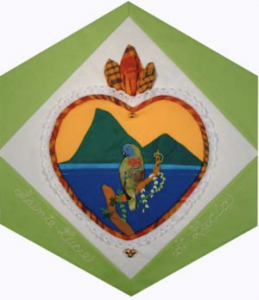Saint Lucia

The Block
A brightly plumed jacquot (endangered parrot specie indigenous to Saint Lucia) perches high on a tree branch at the centre of this block, designed by Avril, Roslyn and Merle Phillips. Satin stitches in an array of colourful threads create the feathered appearance of the embroidered bird, which was patiently stitched by Reina Cross. ‘The Pitons’––dramatic twin coastal peaks that soar more than 600 metres up from the sea––stand tall in the appliquéd background, while eyelet lace peeks out from behind madras-covered cording to frame the scene. Such lace is typically used as trim on petticoats worn under madras skirts, which are part of traditional attire.
Gold beads embellishing the block are symbolic of the abundant jewelry Saint Lucian women wear to complete their ensembles. The design is crowned with a piece of madras, tied like a customary tête en l’air. The headdress is more than just a part of the national costume. It is also a reflection of the woman who wears it, for the manner in which it is tied reveals her level of romantic commitment. One peak says, ‘my heart is free,’ two mean ‘my heart is engaged but you can try,’ three say, ‘my heart is engaged,’ and four mean ‘anyone who tries is welcome.’
Cultural Profile
The tiny island nation of Saint Lucia, only 44.5 km (27 miles) long and 22.5 km (14 miles) wide, is located in the eastern Caribbean Sea. An area of active volcanoes, it is home to some of the world’s most beautiful scenery, including the National Rain Forest. Mount Soufrière is known as the world’s only ‘drive-in’ volcano because of the road leading to its edge . Originally inhabited by the indigenous Caribs, the island was fought over by the French and the English for over two centuries. This resulted in English being the official language, although a French patois is also spoken and written, making the literature of Saint Lucia a unique cultural product.
Saint Lucia’s people have a reputation for their warmth and charm. The culture has evolved from the intermingling of many diverse groups, including Europeans, Africans and East Indians, who have been part of the history. The different beliefs and traditions brought by each are reflected in today’s island life. The island is known for crafts such as boatbuilding, pottery, and woven baskets and palm-frond mats.
Saint Lucian cultural life has traditionally been divided between two ‘societies’ rooted in African traditions: La Woz (The Rose) and La Magwite (The Marguerite). Most islanders belong to one of the two societies which are in charge of organizing ‘seances’ or session, evenings of songs and games, to prepare for their annual festivals. Competition between the two groups can be fierce, though all remain friends. Dance is important to Saint Lucian culture as evidenced in the yearly carnival held each summer.
Many of the immigrants who came to Canada from Saint Lucia settled in Ontario, and a 2011 census reports there are now over 6,600 Saint Lucians living in this country.
Sponsor: Sarah and Elizabeth Krol
